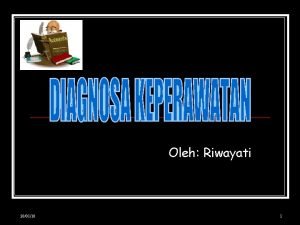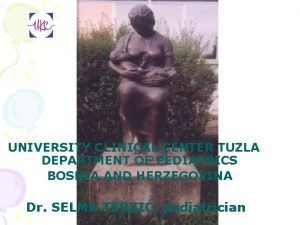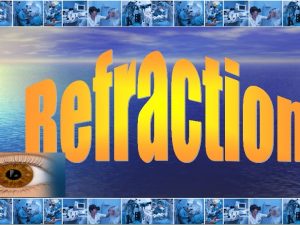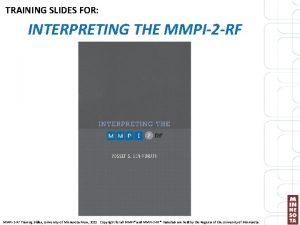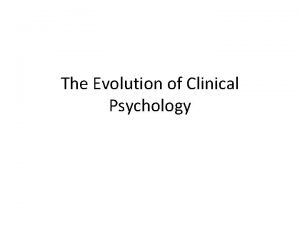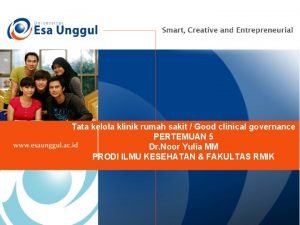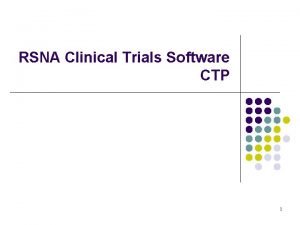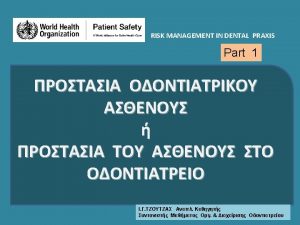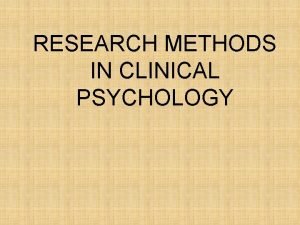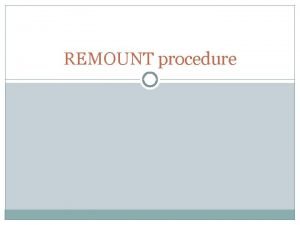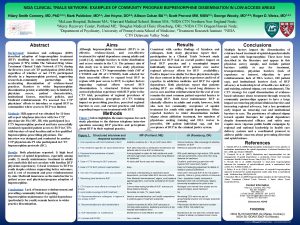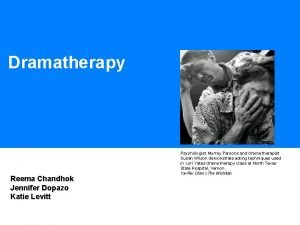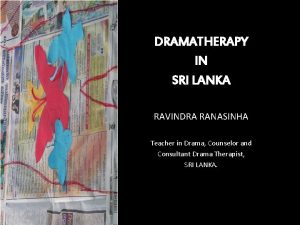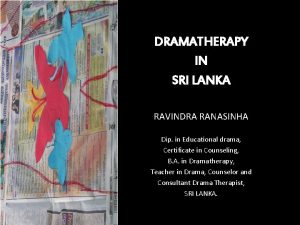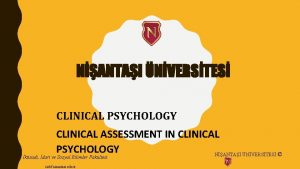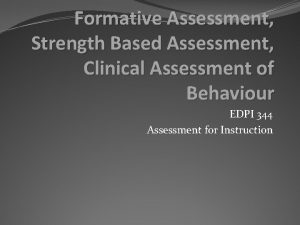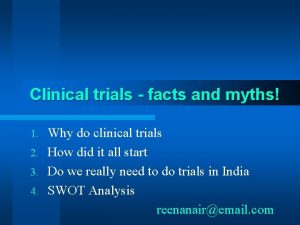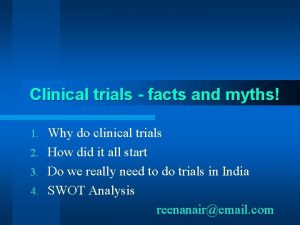Dramatherapy ASSESSMENT Why Assessment Dramatherapy is a clinical










































- Slides: 42

Dramatherapy ASSESSMENT

Why Assessment? Dramatherapy is a clinical practice that uses formal and validated assessment and evaluation tools to measure its effectiveness and outcomes Provides a summary and analysis of the creative-therapeutic work, evidencing change.

Kids with Learning Disabilities, for example: Enhanced confidence, self-esteem and emotional resilience Greater security & self-awareness of safety. Improved communication and socialisation skills Improved concentration, memory, and attention Increased body and sensory awareness Greater awareness of boundaries – space, people Abilities to overcome difficulties with relationships

In Dramatherapy, Assessment is Continuous and Ongoing

Initial Assessment Motivation, willingness for drama therapy sessions Willingness to change, play creatively Clinical history and personal/social background Willingness to play role Ability to communicate

Ongoing Assessment Ability to express feelings, become acquainted, accept feelings of others Find community with the group Make contact with therapist Spontaneity and catharsis Explore personal pain Handle fears, share differences with others

Final Assessment Self-esteem, awareness, acceptance Hope, communication, trust, spontaneity Self-other awareness, social interaction Creativity, initiative, imagination, Concentration, reduced depression Realistic world view, social self-control Physical appearance, use of language

Some Assessment Techniques in Family Therapy Want Ads (for a perfect parent, child, spouse, marriage, solutions, etc. Guided Imagery (imagine a videotaped clip of your last marital argument. Watch it in your mind and, edit it, without changing your partner’s part, but focusing on changes you could make in your own emotional volatility or other responses. Photographs (to trigger discussion and insight, to observe stance and position, to compare before to after, to notice what has not been noticed before) Role-play or psychodrama (to gain a window into family dynamics. Ex: re-enact holidays, dinner table conversations, etc. )

Sculptures (family members can each sculpt the other family members, positioning and expressing them in line with their own perceptions. This can be done comparatively – now and if it were better some day; now vs then). Or each family member can sculpt only themselves, in relation to the group, or can make a doll or position a chess piece. Or in a linear sculpture, members place themselves or each other along a line to denote hierarchy/power in the group, or to indicate position on a family controversy/conflict. Or a couple can be placed in a relationship sculpture.

Incomplete prompts for free association, sentence completion, storytelling, The Talk About game (A person has the ball, states a topic “tell me about …. ” And then tosses the ball to someone who now has 10 seconds to make 5 relevant statements and then choose another topic and toss the ball to someone else. Metaphors (what part of a car would you be and why? What article of clothing/movie/song/ describes you and why? What color are you and each of the others in your family? What fairy tale or nursery rhyme describes your experience? ). Or, think about your family members in a symbolic way, like you were dreaming or like you they are characters in a Bible story, cartoon, historical event, cultural myth, etc. , so that you can describe your family in relation to one another.

Dramatherapy Results are Visible Engages in productive and self-fulfilling activity Sustains emotionally warm relationships Enjoys non-serious activity like playing, just for the fun of it Appreciates the quality of life, beauty and mystery of life, and expresses it

Cognition Evidenced through all senses Emotions felt through senses Uses touch as communication Uses sounds as expressions Being happy in their own company and in the group Capable of deep relationships with others

Case Study 1 – Madurai Prison One year 2001 -2002 weekend workshops with 10 life convicts Problems: depression due to loneliness and suppressed sexuality X had not laughed once in 5 years Always lonely Intervention: games , improvisation, enactment through stories

Process and Outcome Play back theatre through improvising Imaging Narrating stories based on imaginary situations Improvised with objects Opportunity to fantasize sexuality X laughed as he clowned

Case 2 – Madurai Prison A case of acute mutism: schizophrenia Passive withdrawal symptoms. Lack of social life and interaction His problem: powerless emotions, autistic tendencies Need for communication and the rejection or the fight against communication He can speak but refuses to speak.

Process and Outcome Tried to introduce games involving interaction His interest in the TV serial Sahana was an opener to break ice Improvising with sounds: music played on tape Music appreciation: begins to tap fingers Learned to use sounds as communication: ability to communicate improves. Begins to talk

Use and Assessment - Trauma Use with children or adults who have trouble responding to questions or describing feelings in verbal form. Useful in addressing specific somatic manifestations of trauma (i. e. , sensory defensiveness, somatic memories, etc. ). Use for vicarious trauma (therapist trauma) – in negative effects of working with those with trauma. Treating the disruption of therapist’s schemas about the self and the world.

Subjective Units of Disturbance -- SUDs



Somatic Manifestations






Significant Trait Indicated % Incidence in Before Drawings Happy Face 25 Neutral Face 19 Sad Face 35 Angry Face 8 Tears 11 Missing Mouth 14 Head Only 19 Profoundly Long Neck 17 Profoundly Protruding Ears 13 Missing Arms 7 Profoundly Short Arms 15 Injured Limb 1 Melting or No Body Integrity 8 Body as Insect 2 Body as Bird 4 Body as Flower 4 Body as Sun 1 (no face) IDP Status 3 With House 3 Carrying or Doing Something 6 With the Dead 0 % Incidence in After Drawings (sample 1) 44 32 15 2 2 3 15 4 8 0 9 0 6 0 0 0 1 (happy face) 0 8 13 6 Improvement 19 13 20 6 9 11 4 13 5 7 6 1 2 2 4 4 1 3 5 7 6

a move from 43% sad angry to only 17% sad angry a move from 44% happy or neutral to 76% happy or neutral 14% indicating an inability to speak of what happened (missing mouth) to only 3% 17% feeling overly-dependent (very long neck) to only 4% feeling so 13% noting concern with what they hear or have heard to only 8% A complete reduction in missing arms (perception of being unable to extend themselves into the environment to act upon it, to exert intention) from 7% to zero. Reduction in short stunted arms (a stunted ability to exert intention by extending oneself into the environment and acting upon it competently) from 15% to 9% A reduction from 19% of students whose body image lacked integrity (discontinuously drawn or abstract) or was not perceived as primarily human (insect, flower, sun, bird) to only 7%. Some of the birds in the before training self drawings had broken wings, and the sun had no face. In the after training self drawing, all but one sun were human and the sun had a smiling face. Increase from perception of self as active (doing or carrying), 6% before to 13% after

Lali Ghost Child Massacre Trauma ---- Loss, Injury, Death Sad, Needy, Marginalized, Shy Interventions: Music Therapy, Drama Therapy (role-enactment, sensory and video expression), Acknowledgement, Empathy, Love Visible Outcome: Integrated Mandala (spiritual body) She went up and never returned Her brother (spirit) made inquiry and left satisfied

Cyber. Dramatherapy


I focused my research on the process by which avatar development is instrumental in ratava (offline self) transformation. It is evident, based on my data, that transformation is positively correlated with the degree of interpenetration between ratava and virtual embodiment experience. The level of ratava dissociation is high to the extent that avatar actions and attitudes are experienced as being separate from ratava imperative and unanticipated, even at times shocking to the ratava. Because interpenetration refers to the engagement of and impact upon the ratava whose avatar(s) are dissociated to act on the virtual environment, an appropriate criteria for measurement of interpenetration was: What level of ratava dissociation is reached ? To what extent is there seepage (flow of information or degree of re-association from avatar(s) to ratava) ?

I identified four categories of interpenetration: Factitious, Playground, Community, Cyber. Shamanic. These interpenetrative possibilities are based on varying ratios of dissociation and seepage. Low Seepage High Seepage Low Dissociation Factitious Playground High Dissociation Community Cybershamanic

12 Process Driving Dynamics 1. 2. 3. 4. 5. 6. 7. Exposure Trance Self-Expression Self Observation Mythic Ornamentation Space Appropriation Increasing Concern for Non-Corporeal Essentials

8. Depoliticizing Diversity 9. Increased Empathy 10. A Calling 11. Reverence for Elders 12. Recognizing Connection a) Initiatory Dismembership b) Holographic conception of selves c) Hyperspatiality d) Self-Realization

These are the dynamics you can assess also in Dramatherapy. n o i t c e n n n o i t Co n a o z i i l t a p e e c R r e f l P f l Se e S c y i t i h l p a i a t r a g p o s l r o e H p y H

What is Hyperspatiality Outside Cyberspace?

The Embodied Mandala Method as an Assessment Tool in Drama Therapy By Nisha Sajnani 2002 • What provides one with direction • Creative resources Creative Self • What a person is good at Guide Skills Artist Vulnerability • Situations in which one is weak/exposed

The purpose of dramatherapy is to bring these role quadrants into balance, in relation to the core, for wholeness and wellbeing. The more in balance they are, the more growth and dynamic transformation and selfactualization is possible.

Instructions Draw the mandala structure Fill it in with relevant forms Imagine it on the floor Define the quadrants with labels Walk around it slowly, reflecting on its size and content Walk into the first quadrant that attracts you. Gain sensory experience of it by reflecting on questions about its color, temperature, smell, taste, sound, what part of my body does it affect most, what is my breathing like, what surrounds me?

Next, enter the space you feel most comfortable in. Reflect. Enter the space you feel safest in. Reflect. Enter the space that you feel is the least explored in your life The space that gives you confidence The space that provides you strength Now stand in each space with a sculptured stance and provide a monologue of your experience Now stand in the center of the mandala and deliver a brief monologue on your relationship to the other sections of the mandala and also to the world outside the boundaries of the mandala.

Exit the mandala Discuss the experience
 Why why why why
Why why why why Don't ask why why why
Don't ask why why why Penilaian klinis adalah
Penilaian klinis adalah Cas clinical assessment
Cas clinical assessment Nutritional status assessment
Nutritional status assessment Clinical assessment protocols
Clinical assessment protocols National clinical assessment service
National clinical assessment service Why-why analysis
Why-why analysis Why do you cry willie why do you cry
Why do you cry willie why do you cry Does the table represent a function why or why not
Does the table represent a function why or why not What does a table represent
What does a table represent Why or why not
Why or why not Contoh root cause analysis 5 why
Contoh root cause analysis 5 why Principles of portfolio assessment
Principles of portfolio assessment Define dynamic assessment
Define dynamic assessment Portfolio assessment matches assessment to teaching
Portfolio assessment matches assessment to teaching Clinical equipoise
Clinical equipoise Clinical significance of uric acid
Clinical significance of uric acid University clinical center tuzla
University clinical center tuzla Myopia classification degree
Myopia classification degree Clinical scales of mmpi
Clinical scales of mmpi Managing clinical risk
Managing clinical risk Fsfd clinical trial
Fsfd clinical trial Nature of clinical psychology
Nature of clinical psychology Clinical value compass
Clinical value compass Good clinical governance
Good clinical governance Society of clinical research associates
Society of clinical research associates Albumin clinical significance
Albumin clinical significance Dr lemech
Dr lemech Introduction to clinical chemistry
Introduction to clinical chemistry Rsna ctp anonymizer
Rsna ctp anonymizer Clinical risk management in dentistry
Clinical risk management in dentistry Undertaking clinical fieldwork
Undertaking clinical fieldwork Research design in clinical psychology
Research design in clinical psychology Remount jig
Remount jig Clinical refraction of eye
Clinical refraction of eye Pi clinical research consultancy
Pi clinical research consultancy Schistocytes in dic
Schistocytes in dic Acute cholecystitis clinical features
Acute cholecystitis clinical features Outpatient clinical documentation improvement
Outpatient clinical documentation improvement Nsw health rto
Nsw health rto Adams triad
Adams triad Nida clinical trial network
Nida clinical trial network


